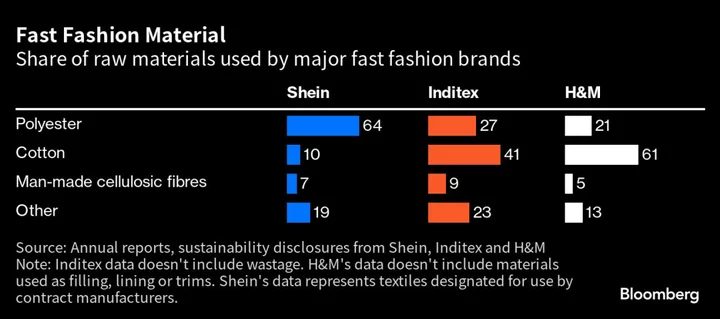Consumers’ drive for quantity over quality is transforming the world’s textile industry, sparking an almost doubling in global fiber production over the past two decades.
Underpinning the explosive growth is synthetics — in particular polyester. Its cheapness, allowing dresses and t-shirts to be sold for as little as a few dollars, has helped make it the most widely used fabric in the world.
But while polyester is durable, resistant to stains and wrinkles and lightweight, it’s also a kind of plastic (derived from a chemical reaction involving petroleum, air and water) and can take upwards of 200 years to decompose. That’s made it a lightning rod for criticism of the excesses of the fashion industry, which produces up to 10% of the world’s carbon emissions and is the second-largest consumer of water.
Read more: How Fast, Cheap Fashion Is Polluting the Planet
A look at recent public disclosures from top fast fashion brands Shein, Hennes & Mauritz AB and Inditex SA, owner of Zara, shows that Shein, the Singapore-headquartered giant that makes most of its garments at factories in China, is by far the biggest user of polyester.
The fabric makes up 64% of its mix versus 27% at Inditex and 21% at H&M.
Shein also only uses less than 1% of recycled polyester, although it aims to transition at least 31% of its polyester-based products to recycled materials by 2030.
Inditex has a target of using 100% recycled or sustainable polyester by 2025 even though only about one-third of its polyester during its latest 2022 winter season was recycled. About three-quarters of the polyester H&M used last year was recycled and it’s working toward hitting a target of 100% in 2025.
Polyester has also become the fabric of choice for the fashion industry more broadly.
In 2021, the fiber had a 54% market share of total global production and just 9 million tons of recycled polyester were made — another sign of the difficulties in transitioning toward more sustainable materials.
Laundering polyester and other synthetic textiles also accounts for the release of about 35% of microplastics that end up in the world’s oceans, according to one estimate. And despite industry vows to ramp up recycling, consumers still throw away tens of millions of garments that end up in landfill, clogging the coast of Ghana or piling up in Chile’s Atacama desert.
Beyond polyester, cotton is another commonly used material that draws scrutiny.
While it’s a natural fabric, meaning it can biodegrade in a matter of months, it involves intensive inputs to grow, process and turn into clothing. Farmers apply pesticides for a conventional crop, which comes with the risk of chemical drift and runoff that can contaminate rivers or soil. It also requires a lot of water — about 2,700 liters (713 gallons), on average, for one t-shirt.
Last year, 92% of Inditex’s cotton was from what it calls preferred sources — organic and from suppliers transitioning toward organic farming, recycled material and ‘Better Cotton,’ crops certified by the world’s largest cotton sustainability program. The company estimates it’ll hit 100% this year. H&M says it sources 100% of its cotton from recycled, organic and other more sustainable sources including Better Cotton.
Shein only uses 10% cotton but has found itself in the spotlight due to concerns about its sourcing practices.
A November 2022 Bloomberg News report used laboratory testing to determine that garments ordered from Shein were made of cotton from Xinjiang, a region in China’s northwest that’s been accused of human rights violations against its Uyghur population.
Shein says it’s since established robust traceability of its cotton supply chain, including a propriety system that integrates documentation, that is committed to respecting human rights and that has zero tolerance to forced labor.
Read more: Influencer Backlash Is the Latest Threat to Shein’s IPO Plans
Although according to Roosmarie Ruigrok, a sustainable fashion consultant and founder of supply chain information platform Clean&Unique, clothing labels are “hardly read by consumers,” brands are trying to be more eco-conscious.
H&M has said that since 2020, all of its cotton comes from “more sustainable sources” while Shein last year announced a $15 million investment to upgrade its supply chains. Inditex, meanwhile, has pledged to use 100% organic or sustainable cotton in its clothes before the year end, along with only man-made cellulosic preferent fibers — a plant-based fiber.
--With assistance from Jinshan Hong.

